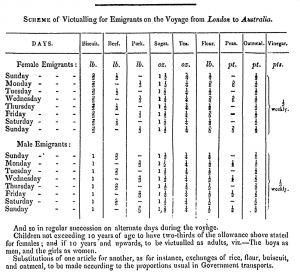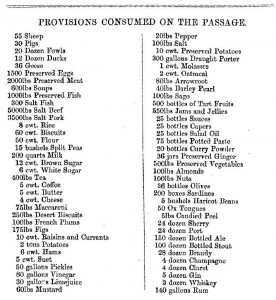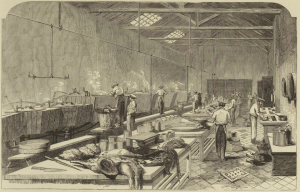The current library exhibition Gusto! a culinary history of Victoria, explores the role food has played in Victoria’s history. One food topic that’s of great interest to many family historians is the shipboard diet – what exactly did our ancestors eat when they sailed to Australia in the 19th century?
The voyage to Australia was long and monotonous, particularly in the early days of travel when a sailing ship could take up to four months to reach Australia. Living conditions were notoriously bad with poor sanitation, cramped quarters and rations that was not much better than what the convicts received. Only when the British government passed several passenger acts in the mid 19th century and set standards for sanitation, space and diet, did conditions improve. The following scale is an early example of one such regulation – a daily dietary allowance passengers who sailed from England in 1837.
Click on image to expand.
(Source: Emigration report, House of Commons Parliamentary Papers, no. 388. p. 18)
This was the scale used in steerage -where the majority of emigrants were housed. The steerage diet was very plain, with meat, potatoes, rice, biscuits and bread, although it has been noted that it was often better than what some emigrants had been used to at home. Second class passengers fared better, with greater quantities of food as well as cheese, ham, tripe, dried fruit and preserved milk. First class passengers had no restrictions and received fresh produce and livestock and preserved goods in abundance. (Source. p. 3-4)
The high standard of cabin class food can be seen in a diary excerpt that appears in the book Life and death in the age of sail. Frances Thomson sailed to Australia on the Selkirkshire with her husband – the ships surgeon. In her diary she writes that they dined with the Captain each day and consumed “three or four courses to dinner every day and everything of first class quality. Today we had two kinds of soup, roast fowl, boiled fowl and sailors corned beef, mashed potatoes, carrots and turnips, cauliflower, then tarts and pudding.. almonds, raisins, nuts, figs and other things” Breakfast included “potatoes, beef steak, curried lobster, whiting and other things too numerous to mention”. (Source: p. 286).
There are many other books in our collection that look at the emigrants journey to Australia. Or for a first hand account consult one of the shipboard diaries or ship newspapers that we hold. These diaries provide a fascinating insight into the day to day routine each person endured – the weather, the relationships, the gossip and of course, the food. Here are a few selections from some of the diaries in our collection.
In 1838 John Sceales travelled to Australia on the North Briton On September 11 he wrote “had a nice breakfast this morning – toast eggs, and warm roast pork, quite at home this morning”. However on September 23 he reported that “the beef was really so bad that our cabin folk called for the Doctor. He came and after seeing the beef, which is the worst I ever saw.. said the beef did not appear to be wholesome”. The beef was later turned into soup! Whenever a sheep was slaughtered John would happily request the stomach so he could make haggis pudding for his family and the other Scottish passengers. (Source: p. 12 & 20).
Meal time in Steerage. (Source: Illustrated London News. 13 April, 1844, p. 229)
1882 Charles Westmoreland and his family travelled to Australia on the Melpomene. Charles was appointed Mess Captain and was responsible for collecting and distributing rations to the six passengers in his `Mess’. In his diary he wrote “we have on Sundays, tin’d beef and carrots, Mondays soup and pork. Tuesdays, boiled salt beef and potatoes, Wednesdays tin’d beef and carrots or perhaps onions (preserved). Thursdays soup again with pork. Fridays tin’d beef or mutton with potatoes, Saturday’s boiled salt beef, these are for dinners, for breakfast you have coffee or tea … and bread and butter, the same for tea”. He added “I have heard some of the people grumble and say they have not sufficient meat to eat, some even have been to the Captain to complain, I think without occasion” (Source: p. 8).
William Crellin traveled on the `Australian’ in 1882 and published a guide for intending emigrants. He recommended “To any one who may contemplate coming here, I should say, bring out some few comforts for use during the voyage, such as a ham or two, and some kind of cakes, especially gingerbread. If allowed, bring also some bottled porter or stout, and some brandy. All but the most inveterate teetotalers drink more of time latter during the voyage than they would anticipate”(Source: p. 41).
Click on image to expand.
True Briton provisions list, (January 14, 1871, p.32)
Rations mainly consisted of preserved foods and the meat of livestock slaughtered on the ship. So when a ship docked at a foreign port it was important for the crew and passengers to ‘stock up’ on fresh produce. In the ships newspaper The True Briton Observer, it was reported that when the ship docked at the Kerguelen Islands, in the Indian Ocean – the crew gathered “a valuable kind of cabbage which grows on the island”. “To a human being under any circumstances, especially sailors having lived on salt meat, this is a most important vegetable, for it possesses all the essentially good qualities of its English namesake, for one hundred and thirty days our crews required no fresh vegetable but this, during which time there was no sickness”. (Source: January 14, 1871, p.25)
Finally, for something far more palatable here is an entry from the diary of Emma Tompsitt. The Tompsitt family travelled Cabin Class to Australia on the steamer Rome. and during a short stay in Colombo they stayed at the Galle Face Hotel. She describes one of their nightly dinners “First came soup, then fish, fowls, joints and sweets, all cooked according to the Indian fashion—some were very hot with condiments, and, being curious enough to taste them all, I got my mouth burnt. After dinner came time fruit, mangoes, bananas, prickly pears, pineapples”. (Source: p. 22)
To find out if there was a diary or journal for the ship your ancestor travelled on consult the:
Log of logs: a catalogue of logs, journals, shipboard diaries, letters, and all forms of voyage narratives, 1788 to 1988. Written by crew and passengers. Each volume lists known works and includes the name of a library or archive where you can find the work. An online version of Log of logs can be accessed here.
For further information on ships please go to the Ships and Shipping research guide.
Richie and McCalls Preserved Meat Establishment. A major supplier of preserved foods to shipping companies.
(Source: Illustrated London News. 31 January 1852, p. 93).






Dear Ann – nowhere can I find a list or even suggestions as to what items our immigrant forefathers and foremothers packed within their trunks and bundles as they boarded the ships that brought them to our shores.
Are you able to help, please?
Jannita
Hi Jann,
The following UK and Victorian government publications provide details of interest:
Great Britain. ‘Colonial Land and Emigration Commissioners. Colonization Circulars, 1843-1873‘. These ‘Circulars’ have been digitised and can be found at: https://www.nla.gov.au/ferg/issn/14614278.html Details given in ‘Outfit for Emigrants’ to Australia were published in issues of the Colonial Land and Emigration Commissioners ‘Colonization Circular’. The ‘Outfit Required’ published in issue number 12, June 1852, page 28 can be found on page 28 at: https://www.nla.gov.au/ferguson/14614278/18520600/00000012/25-32.pdf
The ‘Outfit Required’ published in issue number 16, April 1856 can be found at: https://www.nla.gov.au/ferguson/14614278/18560400/00000016/41-48 on pages 40-41.
These ‘Circulars give a variety of information for intending emigrants to Australia. The 1856 ’Circular’ has an ‘Abstract for the 1855 ‘Passenger’s Act’ giving regulations relating to emigrant ships. The ‘Abstract’ can be read at: https://www.nla.gov.au/ferguson/14614278/18560400/00000016/41-48.pdf beginning on page 43.
Information for intending emigrants was published in the ‘Immigration. Report of the Immigration Agent upon Colonial Emigration and Immigration for the year 1857’ in ‘Victorian Parliamentary Papers. Legislative Assembly. Volume 2. Number 22. 1857-8.’ (Page 35 of the Report). I found this Report in our microfilm copies of the ‘Victorian Parliamentary Papers’, however, I could not find a digitised version of it in the ‘Parliament of Victoria. Parliamentary papers Database’ at: http://www.parliament.vic.gov.au/vufind/ I will email a copy of the ‘Outfit for Emigrants’ section of the Report to you.
Good luck with your on-going research.
Grant Hamston